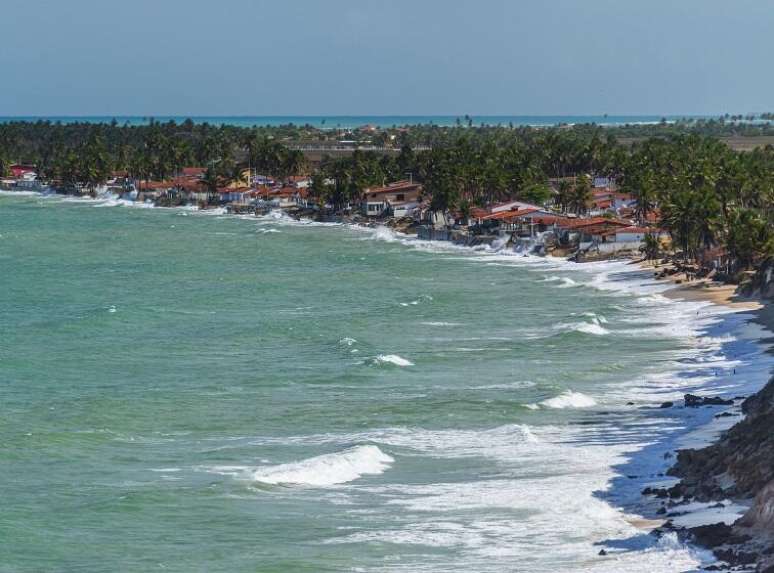Rising sea levels pose a global threat, especially to islands and coastal cities. What are the causes of this phenomenon and how can we react?
“The ocean is overflowing,” warned United Nations Secretary-General António Guterres on a recent visit to Tonga. The South Pacific archipelago is one of several countries in the region under serious and disproportionate threat from sea level rise.
While low-lying islands are particularly the most vulnerable, many coastal communities and cities around the world are already grappling with more destructive floods and storms that put lives, jobs and crucial infrastructure at risk.
Rising sea levels pose a global threat, especially to islands and coastal cities
(Photo: Getty Images)
How fast is sea level rising?
THE Global sea levels have risen faster since the beginning of the 20th century than at any time in the past 3,000 years.and the pace continues to accelerate.
Since records began in 1880, levels rose by more than 20 centimetreswith a pace that gets faster every decade. According to the World Meteorological Organization (WMO), global mean sea level has reached a record high in 2023.
The level does not rise uniformly across the world due to ocean dynamics and the Earth’s uneven gravitational field. In some areas of the southwest Pacific, sea levels have risen at nearly double the global rate since 1993.
The rate at which the oceans continue to rise will depend on global warming.
If global temperatures remain below 1.5°C, as required by the Paris Climate Agreement, and the goal of net-zero emissions is achieved by 2050, global sea levels are expected to rise by 38 centimeters by 2100. But with climate action, the current climate puts us on a path to global warming of 2.7°C by the end of the century, which is expected to result in a further increase of 56 centimeters.
It might seem like a few centimeters doesn’t mean much, but scientists estimate that every 2.5 centimeters of sea rise equates to 2.5 meters of lost beach. Additionally, high tides and storms can cause this to go even further. Similarly, for every centimeter of sea level rise, an additional 6 million people are estimated to be exposed to coastal flooding.
In extreme cases, scientists predict that human activity could cause sea levels to rise by up to two meters by the end of the century.
What causes this increase?
Sea levels are driven by global warming, caused by carbon dioxide, methane and other emissions released from the burning of fossil fuels for purposes such as energy, industry and transportation.
This causes the oceans to warm.
- You the seas have absorbed about 90% of atmospheric warming in the last 50 years;
- the pace of Ocean warming has doubled in the last 20 yearsgrowing three times faster than the global average in the Southwest Pacific;
- ocean temperatures in 2023 they were the highest ever recorded;
When water heats up, it increases in volume due to a process known as thermal expansion. Changes in land water storage – for example, through groundwater pumping – can also lead to a change in the volume of water in the ocean.
However, one of the The main causes of sea level rise are the melting of ice sheets and mountain glaciers due to callus.A. On average, 150 billion tons of ice mass are lost each year from Antarctica and another 270 billion tons from Greenland.
Recent scientific studies also raise concerns about so-called climate tipping points, where temperature increases above 1.5ºC could trigger climate change. irreversible collapse of all ice sheets in Greenland and West Antarcticawith serious repercussions on sea level.
Europe, USA, Asia and Africa at risk?
Small, low-lying islands such as Fiji, the Maldives and Tuvalu face some of the most serious threats from rising sea levels. In these places, even a moderate increase could pose an existential danger.
However, rising sea levels pose a global threat, as nearly 40% of the world’s population lives near coasts and approximately 900 million people live in low-lying areas.
Coastal cities and communities around the world are already grappling with erosion and the challenges facing agriculture and freshwater supplies salt water intrusionas well as increasingly destructive floods and storms.
According to a 2022 study, tropical regions they are expected to be among the hardest-hit places, particularly in Asia, with greatest risks for Bangladesh, India and China. Some of the most vulnerable areas will be river deltas – the vast areas where rivers flow into the sea, where port cities are generally located.
Megacities such as Cairo, Lagos, Los Angeles, Mumbai, Buenos Aires and London are expected to face severe repercussions.
How can we react?
Ultimately, experts say The solution to avoiding a dramatic rise in sea levels is to rapidly reduce emissionsS.
Even so, some degree of sea level rise will be inevitable. This is because, even if the world stopped emitting all greenhouse gases tomorrow, there would be a delay in the effect of global warming on ocean temperatures and melting ice.
Countries around the world employ a variety of adaptation measuresfrom creating retaining walls and storm barriers to improving drainage systems and flood-resistant buildings.
Some of the adaptation measures are simple and nature-based; from preventing coastal erosion by planting wooden piles on beaches in Senegal or regenerating mangrove forests in Cameroon.
For small island nations, responses to rising sea levels include moving entire villages to higher ground, as in Fiji, building floating cities in the Maldives, and reclaiming land swallowed by the sea in Tuvalu.
Many developing regions need financial help to cope with rising sea levels and other consequences of climate change, experts point out.
Source: Terra
Rose James is a Gossipify movie and series reviewer known for her in-depth analysis and unique perspective on the latest releases. With a background in film studies, she provides engaging and informative reviews, and keeps readers up to date with industry trends and emerging talents.



-1jeadvgqd52k9.jpg)
![Un Si Grand Soleil Preview: Episode Summary for Wednesday, October 22, 2025 [SPOILERS] Un Si Grand Soleil Preview: Episode Summary for Wednesday, October 22, 2025 [SPOILERS]](https://fr.web.img2.acsta.net/img/0e/67/0e6770bb5a7db892123914fb7afca318.jpg)


